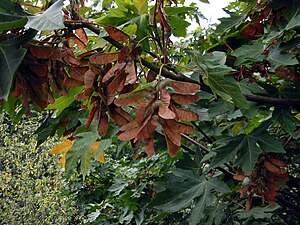Oregon maple
| Oregon maple | ||||||||||||
|---|---|---|---|---|---|---|---|---|---|---|---|---|

Oregon maple ( Acer macrophyllum ) |
||||||||||||
| Systematics | ||||||||||||
|
||||||||||||
| Scientific name | ||||||||||||
| Acer macrophyllum | ||||||||||||
| Pursh |
The Oregon maple ( Acer macrophyllum ), including Big Leaf maple called, is a plant of the genus of the maples ( Acer ). The home of this deciduous tree is in western North America .
description
The Oregon maple grows as a fast- growing tree and reaches heights of up to 30, in individual cases up to 36 m with trunk diameters of up to 1.3 m. Growing in the dense forest, it forms a slender crown and becomes highly knotless up to about half of the trunk. In the open it forms a wider, looser crown. It often also grows with multiple stems. The bark of young trees is brown-red to brown-green with pink lenticels, later predominantly dark gray and breaking up into field ridges, with the furrows being dark orange. The young twigs are very thick compared to other maple species and initially dark green with small white lenticels.
The leaves are the largest of any maple species. The leaf blade is usually five-lobed, rarely seven-lobed and 19 to 27 by 25 to 35 cm in size. The huge leaf is very thin and sits on a 20 to 30 cm long yellow-green to red stem. The middle lobe itself is three-lobed and has few blunt teeth; the other lobes are almost imperforate and mostly smooth-edged. The upper side of the leaf is dark green to dark yellowish green and shiny. The underside of the leaf is slightly lighter and has axillary whiskers along the midrib. The autumn color in the natural locations is gorgeous bright orange with shades from yellow to brown. In Central Europe , on the other hand, the leaves usually only turn dull brown in autumn.
The Oregon maple is monoecious ( monoecious ), that is, each tree copy developed simultaneously male and female flowers. The flowers appear on overhanging, 10 to 25 cm long panicle inflorescences after the leaves shoot in May. The light greenish-yellow flowers are about 3 mm in size.
The fruits are winged and in pairs, with the wings spreading at right angles. The fruit is about 5 cm long and 2 cm wide. The seed nuts are thick and hairy with bristles.
distribution
The home of the Oregon maple is in western North America near the Pacific coast; in north-south direction, the deposits extend from the southeastern part of Alaska through the western part of the Canadian province of British Columbia and the US states of Washington and Oregon to northern California .
The Oregon maple has been planted relatively rarely in Central Europe . As a young plant, the species is still sensitive to frost here. An exceptionally large specimen, around 25 m high and with a trunk circumference of 2.50 m, grows in the Bochum city park .
use
The wood is used, among other things, in furniture production, for example for solid maple table tops, as well as for carving and turning work. The tree also makes excellent firewood .
Young twigs, like willow branches, are suitable for wickerwork. The tree sap can be used in a similar way to that of the sugar maple , but is not quite as sugary. The leaves are used in the kitchen to wrap foods that are to be gratinated, such as fruit or root vegetables. The yellow nectar-containing inflorescences are also edible.
Systematics
The first description by the German-Canadian botanist Frederick Traugott Pursh was published in 1813/14. There is also a variety Acer macrophyllum var. Kimballi Harrar with deposits in the US state of Washington have been described.
Within the maple genus ( Acer ), the Oregon maple is placed in the Lithocarpa section , Macrophylla series .
Individual evidence
- ^ Plant portrait in the yearbook of the Bochum Botanical Association, Volume 1, pp. 177–179, 2012
- ↑ Fl. Amer. sept. 1.1813-1814, 267, see entry in GRIN Taxonomy for Plants .
- ↑ See section "Genetics"
literature
- Alan Mitchell: The forest and park trees of Europe. An identification book for dendrologists and nature lovers . Translated and edited by Gerd Krüssmann. Paul Parey, Hamburg / Berlin 1975. ISBN 3-490-05918-2
Web links
- Plant description by Don Minore and John C. Zasada. In: www.na.fs.fed.us. (English)
- Oregon maple In: www.for.gov.bc.ca. (English)
- Data sheet at USDAFS (English)
- Oregon maple. In: Plants for a Future. (English)
- Oregon maple. In: USDA. (English)


